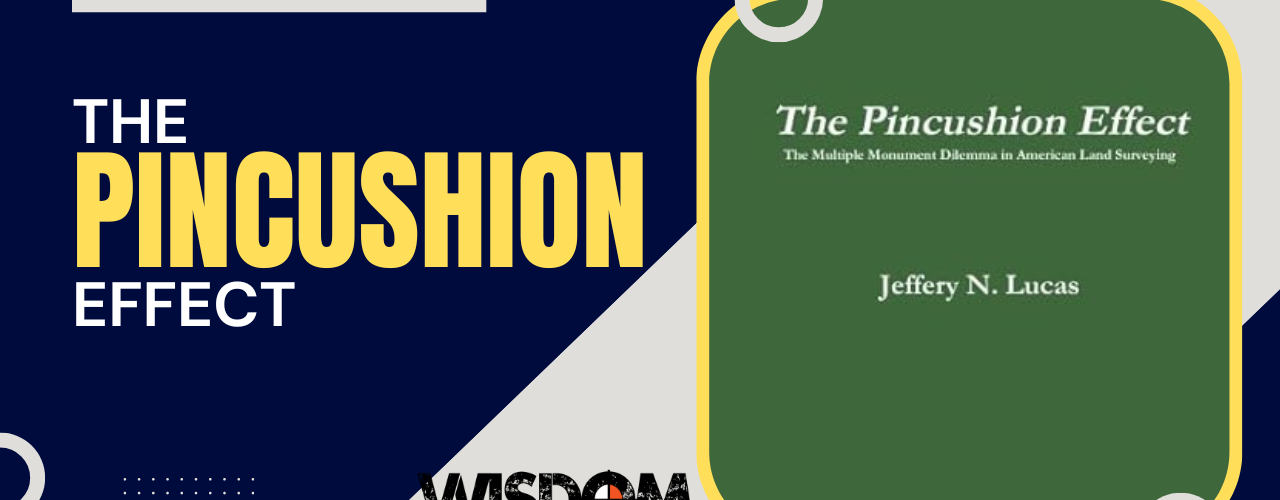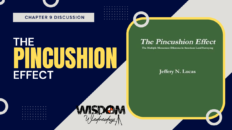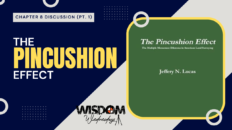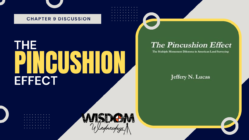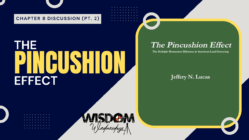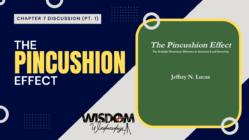Wisdom Wednesdays for the land surveying profession is a bi-weekly roundtable discussion to go over a chapter at a time from our “Surveying Bibles.” The goal is for everyone to read a chapter of a book and then have a roundtable discussion about that chapter. The current book being discussed is The Pincushion Effect by Jeffrey Lucas.
About the book
American land surveying has a dilemma; it’s called the “pincushion corner.” This is a name used to describe the phenomena of multiple boundary monuments being set by land surveyors when only one boundary corner exists under the law. The pincushion has not gone unnoticed by the legal profession and the general public. It is now common knowledge that no two surveyors can agree on the location of any given property corner. The pincushion is physical proof of that notion. Not only is the pincushion becoming a public relations disaster for the profession, it is causing those who might otherwise consider commissioning a survey to decide otherwise. And herein lies the dilemma; no one wants to hire the surveyor because of the way surveying is practiced, the pincushion being emblematic of that practice. This book explores the effect of the pincushion, how the phenomenon started, why it exists, and remedies to end the practices that allow the pincushion corner to not only exist, but to flourish.
Here are the links to the articles we spoke about during this session!
https://www.americanbar.org/content/dam/aba-cms-dotorg/products/inv/book/215341/Chapter%201.pdf
Below is the Zoom AI Summary for this session!
Quick recap
Next steps
The meeting involved a group of people discussing various topics, including personal appearances, changes, and the presence of representatives from Utah and California. They also discussed the importance of property rights, surveying practices, and the challenges of applying mathematical formulas to solve boundary problems. The conversation ended with plans for a mentoring session and a discussion on roles, technicians, and professionals in the next meeting.
- All participants to read Chapter 1 of “The Pincushion Effect” before the next meeting.
- Trent Keenan to post the link to the ABA article “What Every Lawyer Should Know About Title/Property Surveyors” on the website.
- Jocelyn to continue emphasizing the “it depends” nature of surveying to students and explaining the reasoning behind different scenarios.
- Trent Williams to prepare discussion points on surveyors’ roles as technicians vs. professionals for the next meeting.
- Jeffrey Lucas to attend as many future book club meetings as possible to provide author insights.
- All participants to reflect on how their surveying practices have changed in recent years based on discussions and readings.
- Trent Keenan to schedule and organize the next Mentoring Monday session.
- All participants to prepare thoughts on what makes surveyors professionals for discussion at the next meeting.
Summary
Group Discussion and Personal Updates
The meeting involved a group of people, including Trent Keenan, Trent Williams, David, John, Dean, Tim, and Jeffery. They discussed various topics, including personal appearances and changes, such as John’s beard and Dean’s connection on LinkedIn. They also talked about the presence of Utah and California representatives and the absence of Connie due to a fire evacuation. The conversation ended with an invitation for Jeffery to share his thoughts on the inspiration behind a book he authored and what he hopes people get out of it.
Surveying and Law School Experiences
Jeffery shared his experiences as a land surveyor and his transition to law school, expressing confusion about certain practices and noting more alignment with the legal profession. He discussed the approach to boundaries, suggesting a starting point and estimate were sufficient for an expert measure. Jeffery also shared his experiences with legal research and his work on a book about surveying practices. Trent Keenan and Trent Williams shared their own experiences as surveyors, highlighting the lack of proper mentoring and guidance in the field. They appreciated Jeffery’s insights and encouraged others to share their learnings.
Property Corners, Monuments, and Pincushion Corners
Trent Williams explained the distinction between a property corner, which is a theoretical position defined by deeds or surveys, and a monument, which is the physical marker. He highlighted the issue of multiple monuments at one corner location, known as a ‘pincushion corner’. The team discussed potential reasons for this problem, such as miscommunication, fear of admitting mistakes, and ambiguity in retracement surveying. They emphasized the importance of finding established boundary lines on the ground rather than correcting previous errors. The conversation also touched on challenges faced by surveyors in Northern Virginia and the need for education among regulatory authorities.
Discussing Surveyor Perception and Original Surveyor Concept
James expressed concerns about the public’s perception of surveyors and the profession’s credibility. He suggested that surveyors are not uncovering all the evidence and are not applying legal principles correctly. He also questioned the authority of the original surveyor, stating that it comes from the intent of a conveyance, not because it was the first or original. Mathew agreed with James, emphasizing the need to understand the history of surveying and the reasons behind the discrepancies in the profession. Trent then led a discussion on the concept of an “original surveyor,” questioning how to define and give clarity to this term.
Original Surveys and Land Surveying Concepts
The team discussed the concept of an ‘original survey’ and its significance in land surveying. They agreed that an original surveyor is someone who creates a new division of land based on the landowner’s instructions, and this role is not limited to the first surveyor of a property. They also discussed the importance of original monuments in land surveying, emphasizing that they represent the boundaries of property rights and are considered authoritative due to their long-standing acceptance by the public. The team also touched on the idea of ‘unity of ownership’ as a key factor in determining an original surveyor. The discussion was part of an introduction to a book on land surveying.
Property Rights and Surveyors’ Roles Discussed
Jeffery emphasized the importance of property rights and surveyors’ role in maintaining them, suggesting a statute of limitations for disputes. Trent Williams discussed surveyors’ evolving role from boundary creators to retracement experts and arbiters over boundaries, highlighting the need to communicate scope clearly. Curtis Brown initially advocated for surveyors as fact finders but later emphasized open communication with clients.
Challenges of Applying Math in Surveying Discussed
The meeting focused on the challenges of applying mathematical formulas to solve boundary problems in surveying. Trent Williams emphasized that surveying involves thought, process, and evaluation, which are not easily captured by math. David agreed, noting that surveying is a gray field, unlike math which is black and white. James highlighted the importance of understanding the law in surveying, comparing it to a specialized practice of law. He also mentioned an article from the American Bar Association about property surveyors. The team discussed the need for a comprehensive understanding of surveying, with Trent Keenan sharing a link to a relevant article. The conversation ended with a discussion about the book “The Guide to the National Standards of Practice for Surveying,” which was suggested as a potential resource for the team.
Surveying Complexity and Teaching Approaches
Trent Williams expressed his frustration with the complexity of surveying, particularly when dealing with rare and unique boundary issues. He suggested that students should be encouraged to explore these complexities themselves. Jocelyn, an instructor, shared her approach to teaching introductory surveying classes, emphasizing the importance of critical thinking and research skills. The group also discussed the upcoming book on pincushion corners, with Trent Williams highlighting its importance in understanding the topic. The team agreed to continue their discussions until June 1st, with the next meeting focusing on roles, technicians, and professionals. Plans were also made for a mentoring session the following Monday.
AI-generated content may be inaccurate or misleading. Always check for accuracy.


